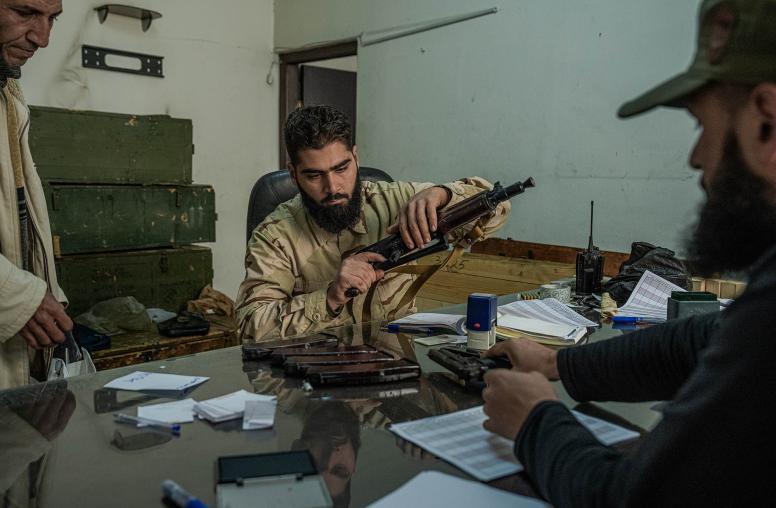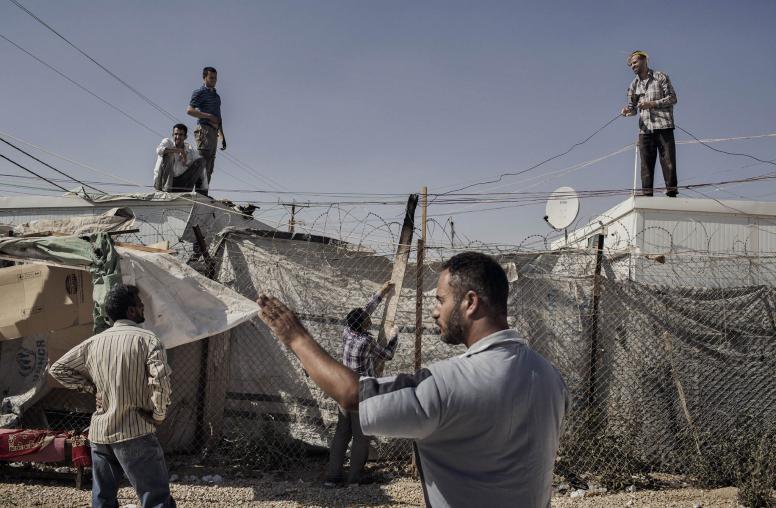Q&A: Will U.S. Strikes on Syria Change Conflict’s Course?
On the Issues with USIP’s Elie Abouaoun and Nancy Lindborg
The United States launched its first air strikes against forces backing Syrian President Bashar al-Assad since the country’s civil war began six years ago, in retaliation for a chemical-weapons attack that killed more than 80 civilian men, women and children. Elie Abouaoun, who is director of Middle East and North Africa programs at the U.S. Institute of Peace and is based in the region, examines the strategic implications, and USIP President Nancy Lindborg, who has worked for nearly 30 years on humanitarian crises and areas affected by conflict, comments on the factors that prompted the U.S. attack.

The American strikes with 59 Tomahawk missiles targeted Syrian aircraft, air defense systems, equipment and infrastructure at Shayrat Airfield in western Syria, the base in Homs Province where the planes responsible for this week’s chemical attack in Idlib are believed to have originated. The Russian military, which has backed Assad’s forces in the war, received advance warning of the U.S. air strikes, the Washington Post reported, citing American officials. Russia ostensibly joined the war to assist in the battle against the ISIS extremist group, which is among myriad discordant forces fighting to oust Assad and seeks to establish an Islamic caliphate across northern Syria and Iraq. But Russia’s operations frequently have hit opponents of Assad considered to be more moderate.
Were these U.S. strikes necessary?
Lindborg: These targeted air strikes were an appropriate response to the unacceptable war crime of using sarin gas on your own people, which is just the latest of a long list of war crimes the Assad regime has perpetrated against the people of Syria. We have limited international tools to stop this level of violence used by a state against its own people. Nothing to date has been effective, especially with the obstructionist role of Russia in the Security Council, where it has repeatedly denied years of barrel bombing, starvation or targeting of health clinics and medical personnel by the Assad regime or even the suffering and humanitarian need that the attacks have generated.
What is the likely effect of the U.S. strikes on Assad and the opposition forces fighting to oust him?
Lindborg: One strike will not solve the wickedly complex conflict of Syria, with multiple terror groups, regional actors with a web of conflicting interests and an utterly destroyed country with nearly half its people displaced. The biggest question is what's next and next and then what.
Abouaoun: If the U.S. military attack is limited to launching 59 missiles, it is not likely to change the course of the conflict, at least not in the short term. It could improve the morale of the anti-Assad forces, but they are not likely to become any more united than they have been, unless the United States, Turkey and Saudi Arabia agree on a joint strategy to support them, leading to enough pressure on Assad to change his behavior or force him to negotiate more seriously.
What would it take for Turkey and the United States to mend their strained relationship to cooperate more on Syria?
Abouaoun: The U.S. would have to persuade Turkish President Recep Tayyip Erdogan to halt his sprint towards the Russians and restore Turkey’s relationship with the U.S. That includes assuring Erdogan that Turkey will be able to influence Syria’s political transition and benefit economically from its reconstruction. He also would want a role in security arrangements in northern Syria. That includes guarantees that Syria’s Kurds, whom he sees as aligned with the Kurdish PKK militant group in Turkey and who have been among the best fighting forces in Syria against Assad, won’t be allowed to establish a mini-state on his border.
How are the Russians likely to respond to the U.S. strikes in Syria?
Abouaoun: The Russians need to understand that the space they had to maneuver under President Obama has shrunk and that it is, therefore, time to bargain. But they also want certain guarantees, such as that Assad and his family will not to be killed like Libyan leader Muammar Qadhafi or imprisoned, as in the case of Egyptian dictator Hosni Mubarak. The Russians want continued control of their Mediterranean naval base in Syria and, like Turkey, to ensure they can influence Syria’s political transition and benefit from the country’s reconstruction.
What reaction might we see from Iran to the U.S. strikes?
Abouaoun: The Iranians are known for their strategic patience. They are fairly unlikely to strike back against the U.S. directly outside of Syria. Iran has a clear agenda in Syria that goes beyond preserving the person or the regime of Assad. It is about access to parts of Syria.
How committed are the Iranians to backing Assad?
Abouaoun: Iran remains the major obstacle to Assad’s removal, contributing thousands of military advisors and support for pro-Assad militias such as the Lebanese Hezbollah and Iraqi militias. Iran’s primary objective is to make sure any regime in Syria either accommodates the Iranian agenda or is too weak to thwart it.


